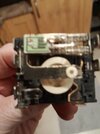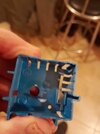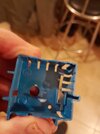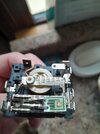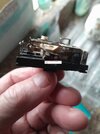I have a 2008 Belling 90E cooker which uses MP-V01-SVC simmerstats, original manufacturer, Invensys.
These have a relativey short life of ~ 2/2.5 years.
I never see any complaints re this short life as this type of simmerstat must be widely used, wonder is this a fairly typical lifespan?, only 2 people in this house.
I had a Creeda Cavalier for 20 years or more cooking for a family of 5 with not one simmerstat failure.
I opened one (failed) up today, and can see that the PCB eventually wears down where the baynot strip end in the cover contacts it due to the very slight pivoting movement of the 5W heating element/bimetal strip as it opens/closes, (rises/falls) the main contacts, the element the will then heat continuously as the 5W heater stops working, until switched off.
Most of the cookers I see in Spain don't use this system, the elements have several spirals and are switched in directly by the control switch.
Look at the red arrows in the attached, if interested.
These have a relativey short life of ~ 2/2.5 years.
I never see any complaints re this short life as this type of simmerstat must be widely used, wonder is this a fairly typical lifespan?, only 2 people in this house.
I had a Creeda Cavalier for 20 years or more cooking for a family of 5 with not one simmerstat failure.
I opened one (failed) up today, and can see that the PCB eventually wears down where the baynot strip end in the cover contacts it due to the very slight pivoting movement of the 5W heating element/bimetal strip as it opens/closes, (rises/falls) the main contacts, the element the will then heat continuously as the 5W heater stops working, until switched off.
Most of the cookers I see in Spain don't use this system, the elements have several spirals and are switched in directly by the control switch.
Look at the red arrows in the attached, if interested.


